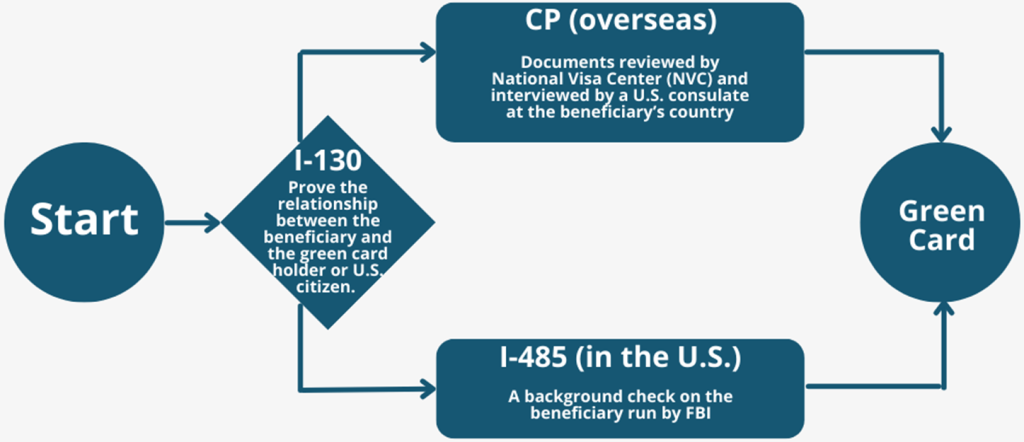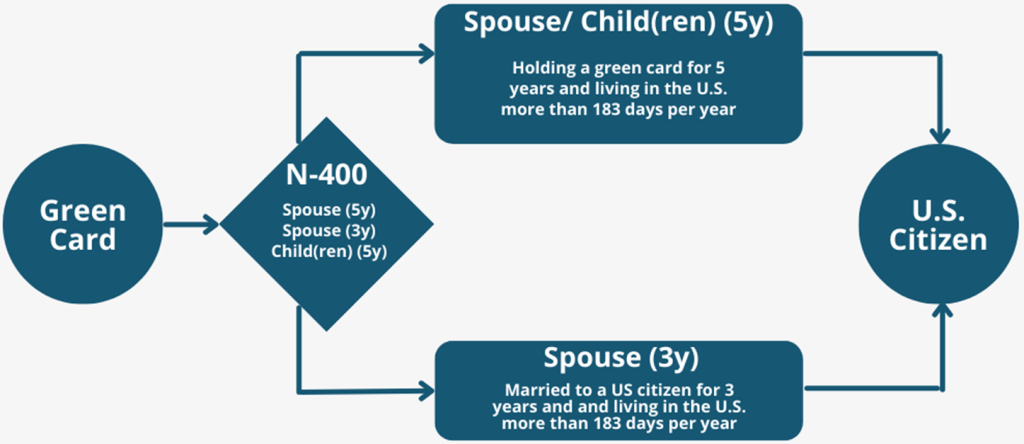If you are a U.S. green card holder, you can only help your spouse and child(ren) apply for their green cards; however, if you’re a U.S. citizen, you can also help your parents and siblings get a green card other than these two.
In addition to whom you can apply for, a U.S. citizen can help the beneficiary (who needs the green card) apply even if the beneficiary is out of status in the U.S. On the contrary, a U.S. green card cannot do such thing.
Overall, becoming a U.S. citizen has more benefits than drawbacks than a U.S. green card holder. We highly suggest U.S. green card holders considering about applying for U.S. citizenship. You need to file your foreign income and assents either way, so why not enjoy the privilege of being a U.S. citizen?
Below is the process of applying for a U.S. green card and then citizenship:


Green Card
- First Preference (F1): Unmarried children (21 years of age and older) of U.S. citizens.
- Second Preference (F2A): Spouses and children (unmarried and under 21 years of age) of green card holders.
- Second Preference (F2B): Unmarried children (21 years of age and older) of green card holders.
- Third Preference (F3): Married children of U.S. citizens.
- Fourth Preference (F4): Siblings of U.S. citizens (if the U.S. citizen is 21 years of age and older).
Conditional Green Card
A 2-year green card issued to spouses of U.S. citizens or green card holders if the marriage is less than 2 years at the time of I-485 approval.
Removal of Conditions on Conditional Green Card:
A Form I-751 petition to remove conditions on a conditional green card can be filed within 90 days before the conditional green card expires, with the following requirements:
- Prove the marriage is genuine and ongoing.
- Both spouses should file jointly (with some exceptions — like divorce or abuse).
K Visa
K-1 Fiancé(e)s of U.S. Citizens: To qualify for a K-1 visa, the following requirements must be met:
- One of the parties must be a U.S. citizen.
- The U.S. citizen and the foreign fiancé(e) must intend to marry within 90 days of the fiancé(e)’s arrival in the U.S. on the K-1 visa.
- Both parties must be legally free to marry, meaning any previous marriages must be legally terminated by divorce, death, or annulment.
- The couple must have met in person at least once within the two years prior to filing the petition. Note: A waiver for the in-person meeting may be requested if it can be proven that:
- The meeting would violate strict and long-established customs of the fiancé(e)’s culture or social practices, or
- It would cause extreme hardship to the U.S. citizen petitioner.
K-2 Children of Fiancé(e): If the fiancé(e) has a child who is under 21 and unmarried, the child may be eligible to come to the U.S. on a K-2 nonimmigrant visa. Must file with K-1 together.
Naturalization/Citizenship (3 Years)
- N-400 Application for Naturalization: A green card holder who is married to a U.S. citizen is eligible for naturalization after 3 years of permanent residency, provided they have physically lived in the U.S. for at least 183 days per year on average during those 3 years.
- N-600 Application for Certificate of Citizenship:
- A person born abroad to U.S. citizen parent(s).
- Already a citizen at birth, wants official proof.
- A green card holder child who derived citizenship automatically when a parent naturalized, and the child met these 3 conditions before turning 18:
- Lived in the legal and physical custody of the parent.
- Was a U.S. green card holder.
- The parent became a citizen while the child was still under 18.

